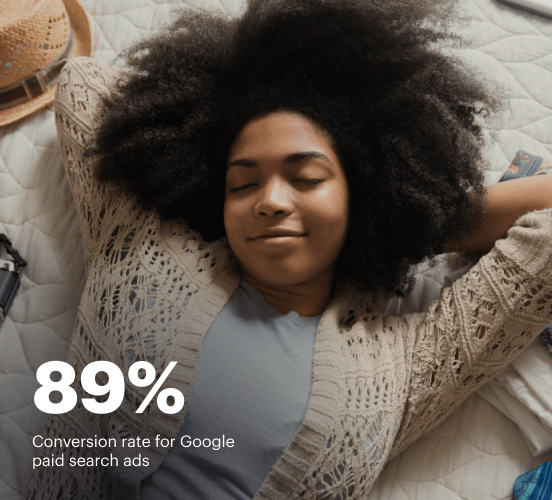WordPress vs. Form.io: the best platform for a seamless web experience
Discover how WordPress compares to Form.io regarding features and usability. Find out which platform provides the competitive advantage your business deserves.
Get startedSee how Instapage stacks up against the competition
| Feature | Instapage | Other builders |
| Drag-and-Drop Tools | ||
| Conversion-optimized templates | ||
| Manual and AI-powered A/B Tests | ||
| AI content suggestions | ||
| Popups and sticky bars | ||
| Canvas and grid blocks | ||
| Reusable and global elements | ||
| Form and popup builders | ||
| Built-in Heatmaps | ||
| Central analytics dashboard | ||
| Ad-to-page personalization and collections | ||
| Contacts, lists, and email | ||
| Dedicated, full-service CRO experts | ||
| Enterprise-ready platform |
Leading the way in building high-performing landing pages





Why Instapage is the smarter choice for your campaigns
Get everything you need to build, scale, and optimize high-converting landing pages—without coding.

Easier page building without coding
Instapage offers a flexible and seamless page creation experience with a library of 500+ conversion-focused layouts, Instablocks®, a drag-and-drop builder, and AI content generation. With technologies like Thor Render Engine®, you can create on-brand, mobile-responsive landing pages that load quickly and start converting during initial visitor clicks.

More insights — better results
Instapage lets you see in detail how each landing page experience and variation is performing so you can make targeted changes that boost page conversions. Use heatmaps for a better understanding of on-page activities, run A/B tests and AI-assisted experiments, and then track and evaluate results within robust analytics dashboards.

More personalized experiences
Instapage lets you quickly create high-performing landing pages tailored to each of your ad campaigns. Deliver personalized experiences for distinct audiences using dynamic text replacement. Effortlessly align specific advertisements to unique pages with AdMaps. Monitor audience-level metrics using our advanced data tools.

Built-in collaboration
Instapage collaboration capabilities bring your entire team together to speed up the process of landing page review, approval, and launch. No more frustrating and unnecessary revisions or edits scattered across emails. Provide instant feedback, conduct real-time page edits, and securely share your pages with outside stakeholders.

Free up time for your business
Invest time into business growth, not busy work. Launch landing pages faster with reusable forms and templates. Build once, reuse forever.
Explore all integrations






Easier page building without coding
Instapage offers a flexible and seamless page creation experience with a library of 500+ conversion-focused layouts, Instablocks®, a drag-and-drop builder, and AI content generation. With technologies like Thor Render Engine®, you can create on-brand, mobile-responsive landing pages that load quickly and start converting during initial visitor clicks.
More insights — better results
Instapage lets you see in detail how each landing page experience and variation is performing so you can make targeted changes that boost page conversions. Use heatmaps for a better understanding of on-page activities, run A/B tests and AI-assisted experiments, and then track and evaluate results within robust analytics dashboards.
More personalized experiences
Instapage lets you quickly create high-performing landing pages tailored to each of your ad campaigns. Deliver personalized experiences for distinct audiences using dynamic text replacement. Effortlessly align specific advertisements to unique pages with AdMaps. Monitor audience-level metrics using our advanced data tools.
Built-in collaboration
Instapage collaboration capabilities bring your entire team together to speed up the process of landing page review, approval, and launch. No more frustrating and unnecessary revisions or edits scattered across emails. Provide instant feedback, conduct real-time page edits, and securely share your pages with outside stakeholders.
Free up time for your business
Invest time into business growth, not busy work. Launch landing pages faster with reusable forms and templates. Build once, reuse forever.
Explore all integrationsGet started with Instapage in a few steps
-
Create your Instapage account
Start with Instapage by signing up via Google or your email. You'll get access to a free 14-day trial to discover Instapage capabilities. Feel free to cancel anytime during the 14-day trial if you decide that our product is not suitable for your business. -
Build and personalize your page
Create your first landing page from scratch or choose a template from 500+ customizable layouts. Use the drag-and-drop builder to add page elements, fonts, and backgrounds, refine content with AI, or add custom HTML, Javascript, and CSS. -
Review and make edits
Collaborate on page designs and streamline review processes. Invite your team members and stakeholders to review, edit, and provide feedback on your landing page. Collaborate knowing your page is confidential and only accessible to authorized users. -
Publish and track page performance
Publish your page to a domain or custom URL. Connect your pages to the ads you've created and track page performance within the analytics dashboard, run A/B tests and AI experiments, analyze results, and continuously optimize your landing page to maintain high conversions.
WordPress vs. Form.io: The Showdown of Digital Titans
In the ever-evolving landscape of digital marketing, choosing the right platform can feel like navigating a maze. The stakes are high as businesses strive to craft compelling landing pages that not only attract visitors but also convert them into loyal customers. The competition is fierce, with a myriad of tools available that promise to streamline the process. Among these contenders are two heavyweight platforms: WordPress and Form.io. Each claims to provide unique solutions tailored for marketers, yet the right choice often comes down to specific needs and goals. Both platforms bring a distinct flavor to the table, and while one may charm the crowds, the other is ready to deliver a knockout punch. As we dive deeper into this comparison, let’s not overlook Instapage, a savvy player in this arena that many consider a game-changer in maximizing landing page potential.
Introducing the Giants of the Digital Arena
WordPress is often seen as the cornerstone of web development, boasting a vast array of plugins and extensive customization options. This platform caters to millions of users, from bloggers to large enterprises, adapting to varied needs with finesse. On the other hand, Form.io addresses the growing demand for form-centric solutions, focusing on creating dynamic forms and data-driven applications. It positions itself as a go-to for developers wanting more control over their forms without getting bogged down in code. However, lurking in the wings is Instapage, a specialist for landing pages that emphasizes high conversion rates and easy A/B testing, making it a formidable alternative worthy of consideration. This diverse trio showcases different strengths, and as we break down the features of each, we’ll uncover what truly sets them apart and where they overlap in their offerings.
Feature Face-Off: A Closer Look at Functions
When it comes to features, both WordPress and Form.io bring their best to the mat. WordPress is known for its user-friendly interface, vast plugin library, and versatility; it can function as anything from an e-commerce site to a portfolio showcase. Form.io, while narrower in focus, excels with its intuitive drag-and-drop form builder and strong API integration. It offers remarkable flexibility for developers who require a robust form solution without extensive coding. Meanwhile, a platform like Instapage increases the stakes further, delivering features focused specifically on landing page optimization, such as heatmaps and advanced analytics. It’s like having a secret weapon in your marketing toolkit, pushing for the highest return on investment. As both WordPress and Form.io flex their features, let’s see who lands on top.
Usability Spotlight: Who Makes the Cut?
Navigating a new platform can be quite the adventure, especially for marketers who might be less tech-savvy. WordPress, with its extensive collection of tutorials and a supportive community, makes for an approachable starting point—with a hint of a learning curve. In contrast, Form.io, while designed for straightforward use, often caters more to developers, which could leave novice users feeling a bit lost. Humorously, tackling Form.io might feel akin to assembling IKEA furniture without the instruction manual – quite the undertaking! Instapage, however, appeals with a focus on simplicity, emphasizing a user-friendly interface that gets newcomers up and running swiftly. Both platforms have unique approaches to usability, appealing to different skill sets, but when it comes to sheer ease of use, Instapage stands out.
WordPress's Power Features:
- User-friendly dashboard for easy navigation
- Extensive library of plugins for added functionality
- Customizable themes to match brand identity
- SEO-friendly structure for better search visibility
- Strong community support and resources available
Form.io's Noteworthy Features:
- Intuitive drag-and-drop form builder
- Robust API for seamless integrations
- Custom validation rules for data accuracy
- Dynamic workflows for complex data handling
Common Strengths of Both Platforms:
- Responsive designs for mobile optimization
- Variety of templates to kickstart projects
- Analytics tools to track user engagement
- Support for various integrations
- Focus on customization options to fit needs
- Secure hosting environments
As we observe these platforms throwing punches in the feature arena, it’s evident that while WordPress and Form.io play their respective hands well, Instapage steps in with a unique flair. Instapage may just be the best alternative for marketers who want powerful landing pages without the complexity. Its specialized focus and features designed for optimal conversion rates make it a significant competitor for both of these platforms.
Performance Punch-out: Speed and Responsiveness
The performance of a website can be likened to a race—faster is always better. Loading times and mobile responsiveness play a significant role in user experience, and by extension, conversion rates. Slow-loading pages can be a deal-breaker, creating frustration akin to wading through molasses during winter. WordPress and Form.io both boast respectable loading speeds, but this can depend heavily on how well the site is optimized, including the choice of hosting. Form.io's backend processes are designed for quick form submissions, generally offering snappier responses for users who prioritize form interactions. Instapage, known for its robust performance optimization techniques, excels at delivering rapid load times even under pressure. A proper platform not only works well on desktop but also adapts seamlessly to mobile devices, catering to the on-the-go audience. Understanding how these platforms handle speed and performance is key to making an informed choice.
Support Systems: The Backup Crew
Support is essential in any platform, acting like a reliable corner team ready to jump in when needed. WordPress has a vast community and numerous forums, ensuring resources are never far away—but finding the right solution can sometimes feel like searching for a needle in a haystack. Form.io provides more tailored support through direct contact but may lack the extensive resource library that WordPress enjoys. On the other hand, Instapage takes the crown for an easily accessible support system—complete with live chat, extensive documentation, and webinars designed to empower users. Support is an often overlooked aspect, yet it plays a critical role in user satisfaction and the overall experience.
The Battle of Pricing: Who Wins?
WordPress's Pricing Perks:
- Open-source platform with a free basic version
- Numerous cost-effective hosting solutions available
- Extensive premium plugins and themes can enhance functionalities at various price points
- Control over ongoing costs allows for budget-friendly scaling
Form.io Pricing Advantages:
- Transparent pricing models based on usage
- Pay-as-you-go options for flexibility
- Tiered plans suited for varying project sizes
- Robust features available from the lower pricing tiers
When it comes to pricing strategies, both WordPress and Form.io present intriguing angles that cater to different types of users. WordPress shines with its free options and breadth of budget-friendly choices, while Form.io captures attention with its scalable and transparent pricing models. However, when we stack them against Instapage, a platform offering exceptional value for money through its dedicated landing page focus and intuitive branding, the contest becomes even more compelling.
A closer look at pricing plans can unveil not only basic costs but the potential hidden values within each offering. While WordPress’s vast plugin landscape may invite additional costs, Form.io’s flexible structures cater to usage patterns. Navigating these waters requires careful consideration of what you're truly getting—and sometimes, the best deals lie in the most unexpected places.
And Then There's Instapage...
Now, let’s shift focus to Instapage, the underdog that has quietly gathered momentum among digital marketers. With a sleek interface and a treasure trove of features designed specifically for landing pages, Instapage stands apart by delivering exceptional usability alongside robust optimization tools. Its ability to facilitate thorough A/B testing and detailed analytics might just make it the secret weapon that businesses didn’t realize they needed. Instapage provides a fine blend of aesthetics and functionality, empowering marketers to take their campaigns to the next level. Users can harness its capabilities to create stunning, high-converting pages without programming knowledge. All this adds up to provide a standout platform that, while acknowledging the strengths of both WordPress and Form.io, presents powerful arguments for why it might just be the best choice for conversion-driven campaigns.
In this landscape of choices, the key takeaway is to aim for clarity in decision-making. Understanding your business objectives and familiarizing yourself with platform strengths will empower you to choose wisely. Whether you lean towards the extensive customization of WordPress, prefer the robust forms of Form.io, or find your match with the seamless functionality of Instapage, the right platform can surely help elevate your marketing efforts and drive significant results. So, as you begin your journey, keep exploring the options available, and don’t shy away from discovering the full potential of Instapage as your trustworthy companion in the world of landing pages.










